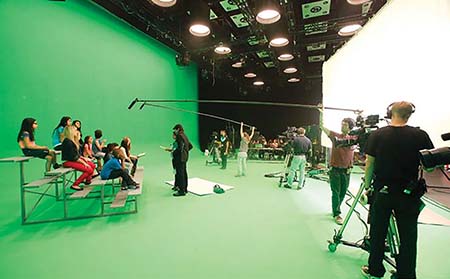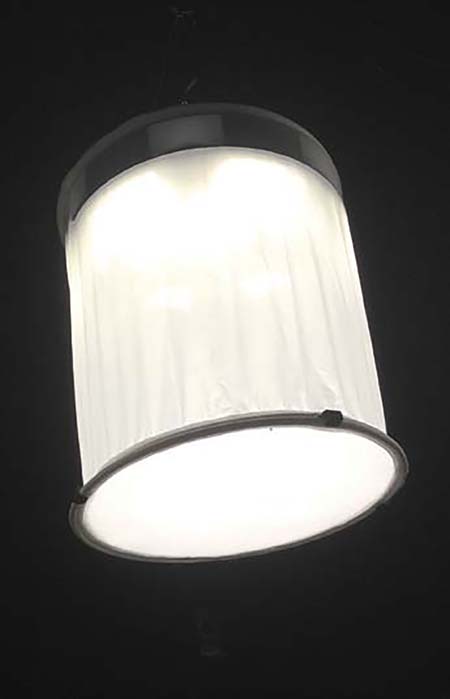Exploring the Use of Space Lights

Jay Holben

The typical Space Light is six 1K “nook” lights, halogen bulbs in a simple reflector, configured pointing straight down in a “star” pattern, like the spokes of a wagon wheel, on a single circular base.
This month’s fixture introduction is the Space Light. Rarely, if ever used as a single fixture, a Space Light is designed to be used in concert with multiple other Space Lights to provide an ambient soft source from above. Space Lights are used primarily on stage, often to create a base daylight ambiance or an overall soft base exposure.
The typical Space Light is six 1K “nook” lights, halogen bulbs in a simple reflector, configured pointing straight down in a “star” pattern, like the spokes of a wagon wheel, on a single circular base. Variations are one-, two, three- and fourlamp varieties. A skirt of diffusion (typically) encircles the cluster of lamps and hangs below them a few feet. A diffusion base can also be clipped onto the bottom to close out the cylinder of light.
Because the individual fixtures can be addressed separately (or sometimes in clusters) and dimmed, Space Lights are considerably flexible in the area of exposure levels with a range of up to two-and-a-half stops (in a six-light fixture).
The type of diffusion skirt is, generally, silk, but is interchangeable. To add some directionality with less spread, a duvetyne skirt can be employed instead of silk to black out the sides of the cylinder and only illuminate the bottom circle of diffusion.
Color gel can easily be cut and inserted into or clipped onto the bottom disc and several companies offer dyed silk in CTB colors to make the fixture a “daylight” color balance. Many cinematographers and gaffers like to alternate “daylight” and “tungsten” Space Lights in a rig to give them flexibility of color temperature for day or night scenes. Typically, “night” Space Lights incorporate the duvetyne skirt and a CTB layer on the bottom diffusion disc to give the “moonlight” a little more top light directionality and keep the light from spilling onto set walls.
The professional video industry's #1 source for news, trends and product and tech information. Sign up below.

Duvetyne skirted Space Lights in use on Universal Studio’s UVS-1 stage for my shoot “Event Premiere.” The fixtures here provide an even illumination of the green floor for the live composite work. Although the diameters of the Space Lights vary, as do the lengths of the skirt, their true strength is in numbers. Clustering a number of Space Lights together can create a “directionless” ambient exposure that feels very much like natural skylight, or mimics ambient moonlight, over a large area.
Until recently, Space Lights were nearly exclusively tungsten fixtures and 6K of tungsten generates a lot of heat and requires a lot of power. Several companies (such as Mole Richardson and Nila, among others) are now manufacturing LED Space Lights, which require significantly less power and generate significantly less heat.
These are much more suitable for a permanent installation in a newsroom, for example, and the reduction in electricity usage and in air conditioning to cool the studio will more than offset the cost of the new fixtures. Although an LED array may not have the output power of a tungsten counterpart, the benefits of savings, as well as ability to have daylight colored or bi-colored LED fixtures in a single Space Light, is incredibly beneficial.

A hanging Space Light There are some other variations on a theme: Bardwell & McAlister make a “skirtless” Space Light utilizing 6 HPL bulbs (originally designed for the ETC Source Four fixtures) with PAR reflectors and lenses to generate a soft overhead source whose spread is determined by the type of lens used. These “skirtless” fixtures require less vertical space and can be used in places with lower grids where a typical Space Light would hang too low. With the HPL lamps, which are designed to output three times the light of a conventional tungsten bulb, this 6K Space Light only requires 3,450 watts as opposed to 6,000 watts of a typical fixture.
I have only ever turned to Space Lights when working on a sound stage with an existing permanent structure. They’re tedious to hang and power, but once they’re in the air, they provide a powerful and efficient system for base exposure and ambient light—especially where greenscreen (or blue) is concerned. Their even field is great for lighting chroma floors.
Jay Holben is also a contributor to Government Video. He is the author of the book “A Shot in the Dark: A Creative DIY Guide to Digital Video Lighting on (Almost) No Budget.”
